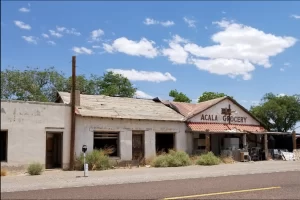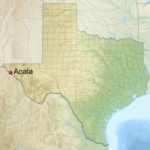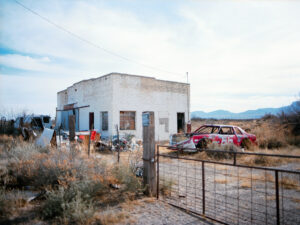
 Acala, Texas was once a “thriving” community…well, ok, maybe not exactly thriving, but it the town’s “heydays” it had a population of about 100 people, who made a living raising Acala Cotton. No, it never was big, but the railroad once went through there to take the cotton crop to the market. Acala is located in Hudspeth County, Texas, approximately 34 miles northwest of Sierra Blanca and 54 miles southeast of El Paso on Highway 20. These days the population is approximately 25 people, making Acala more of a ghost town than the unincorporated community that it is technically listed as.
Acala, Texas was once a “thriving” community…well, ok, maybe not exactly thriving, but it the town’s “heydays” it had a population of about 100 people, who made a living raising Acala Cotton. No, it never was big, but the railroad once went through there to take the cotton crop to the market. Acala is located in Hudspeth County, Texas, approximately 34 miles northwest of Sierra Blanca and 54 miles southeast of El Paso on Highway 20. These days the population is approximately 25 people, making Acala more of a ghost town than the unincorporated community that it is technically listed as.
The area was first settled in the early 20th century. In 1917, three farmers combined their resources to plant experimental cotton near Tornillo, about 13 miles northwest of what is now Acala, Texas. Successful the first year, the men purchased more land the next year to grow irrigated cotton. Hearing about the success of these f armers, a man named WT Young came to the area from El Paso to try his hand at cotton farming, but Young would bring much more to the area than cotton. He bought a large piece of cheap desert land near the Southern Pacific Railroad tracks southeast of Tornillo. Using mules to clear the brush and break the soil for the first time, he planted a Mexican variety of cottonseed called Acala. He was so successful that he built his own cotton gin at the site now known as Acala. It wasn’t the first cotton gin, which was built by Eli Whitney, but it was a cotton gin, and it revolutionized Acala.
armers, a man named WT Young came to the area from El Paso to try his hand at cotton farming, but Young would bring much more to the area than cotton. He bought a large piece of cheap desert land near the Southern Pacific Railroad tracks southeast of Tornillo. Using mules to clear the brush and break the soil for the first time, he planted a Mexican variety of cottonseed called Acala. He was so successful that he built his own cotton gin at the site now known as Acala. It wasn’t the first cotton gin, which was built by Eli Whitney, but it was a cotton gin, and it revolutionized Acala.
The town began to grow, and a post office was established in 1925. It was operated by Mrs Julia Vaughn. By 1929, the population had doubled from 50 people to its peak of 100 people. The population varied over the years, peaking again in the late 1950s, at 100 people. Unfortunately, the town could not maintain the population, and soon declined, once again. By the 1970’s there were about 25 people. Since then, it has remained at that size. Acala is in the Fort Hancock Independent School District. Fort Hancock High School is the district’s comprehensive high school.
The United States Census Bureau first listed Acala as a census-designated place prior to the 2020 census. A 
 census-designated place (CDP) is a statistical geography representing closely settled, unincorporated communities that are locally recognized and identified by name. The designation doesn’t necessarily add any importance or value to the town, however. Nevertheless, the fact that it was at one time a successful agricultural area and operated a successful cotton gin, gives it definite historical value.
census-designated place (CDP) is a statistical geography representing closely settled, unincorporated communities that are locally recognized and identified by name. The designation doesn’t necessarily add any importance or value to the town, however. Nevertheless, the fact that it was at one time a successful agricultural area and operated a successful cotton gin, gives it definite historical value.


Leave a Reply